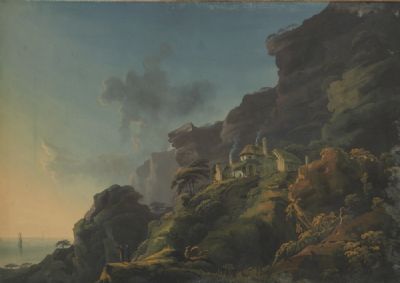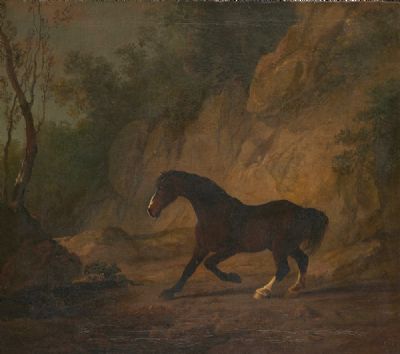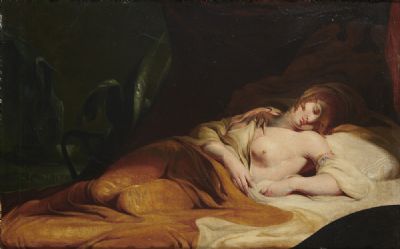Bidding on this item has ended.
James Arthur O'Connor
A SEA PIECE
Lot 59
Price Realised:
€4,400
Estimate:
€5,000 - €7,000
James Arthur O'Connor, 1792 - 1841
A SEA PIECE
Oil on panel, 7 1/2" x 9 1.2" (19 x 26cm), signed with initials and dated 1839
Exhibited: James Arthur O'Connor, The National Gallery, Dublin, Ulster Museum Belfast, Crawford Art Galler...
Read more
 Lot 59
James Arthur O'Connor
A SEA PIECE
Lot 59
James Arthur O'Connor
A SEA PIECE
 Lot 59
James Arthur O'Connor
A SEA PIECE
Lot 59
James Arthur O'Connor
A SEA PIECE
Estimate:
€5,000 - €7,000
James Arthur O'Connor, 1792 - 1841
A SEA PIECE
Oil on panel, 7 1/2" x 9 1.2" (19 x 26cm), signed with initials and dated 1839
Exhibited: James Arthur O'Connor, The National Gallery, Dublin, Ulster Museum Belfast, Crawford Art Gallery, Cork, Nov-1985-April 1986 (No. 84.)
Literature: John Hutchinson, James Arthur O'Connor, Exhibition Catalogue, The National Gallery of Ireland, Ulster Museum, Crawford Art Gallery (Dublin, 1985) p. 187
The size and simplicity of this late work by O'Connor, belies its significance as a harbinger of later developments in landscape painting and particularly the engagement of advanced artists though the nineteenth century with the crash of waves on the sea shore. The fascination that the littoral landscape has exerted on painters from Delacroix, Courbet and Monet to Winslow Homer and Roderic O'Conor is, no doubt, due both to the technical challenge of simultaneously painting the solid and the liquid but also to the symbolic associations that accrue to the shoreline as a liminal space or threshold between different zones or states. Noting the rich impasto and comparatively free treatment of the waves, John Hutchinson wrote of the present work, at the tine of the 1985 James Arthur O'Connor show at the National Gallery of Ireland, 'A Sea Piece is an unaffected, simple picture, probably painted for the artist's own pleasure'.
One of the most appealing of all Irish artists, O'Connor was born in 1792 at 15 Aston's Quay, Dublin, the son of an engraver and print seller. It has been suggested that he trained with William Sadler, and, while this cannot be corroborated, there are occasionally close similarities between their respective small landscapes. O'Connor first exhibited with the Society of Artists in 1809 when he showed The Card Players. This subject piece was to be something of a false start as his interests thereafter were to lie almost exclusively in landscape, and, specifically, the Irish scenery which he loved. The artist was to spend a large part of his career in England, also making several extended tours of the continent. Together with Francis Danby and George Petrie, he travelled to London in 1813, but returned the following year to care for his orphaned sisters. His first great series of topographical landscapes was of Westport, executed for the Marquis of Sligo in 1818/19 (private collection). To the same years can be dated the impressive series of Ballinrobe house and demesne (National Gallery of Ireland). Both of these sets of 'seat portraits' are very much in the eighteenth-century tradition of artists such as William Ashford. In addition, however, to painting elegant demesnes, Norman castles and the more sublime aspects of the Irish landscape O'Connor also enjoyed more workaday subjects showing ordinary Dubliners at leisure.
Although he met with some initial success at home (winning a premium of twenty five guineas from the Royal Irish Institute), in, or about, 1821 O'Connor returned to London ('in dismay...but not disgust') and over the following years he exhibited landscapes at the Royal Academy, the British Institution and the Society of British Artists, of which he was elected a member. In 1825 O'Connor moved to Hampstead where his friend Danby, as well as John Constable, were neighbours and the following year he spent at least six months in Brussels. O'Connor made several further trips to the continent, meeting with some success in Paris, where he was apparently patronised by King Louis Phillipe. Despite these occasional successes, O'Connor was always incompetent at managing his affairs, and he died in poverty in London in 1841.
A SEA PIECE
Oil on panel, 7 1/2" x 9 1.2" (19 x 26cm), signed with initials and dated 1839
Exhibited: James Arthur O'Connor, The National Gallery, Dublin, Ulster Museum Belfast, Crawford Art Gallery, Cork, Nov-1985-April 1986 (No. 84.)
Literature: John Hutchinson, James Arthur O'Connor, Exhibition Catalogue, The National Gallery of Ireland, Ulster Museum, Crawford Art Gallery (Dublin, 1985) p. 187
The size and simplicity of this late work by O'Connor, belies its significance as a harbinger of later developments in landscape painting and particularly the engagement of advanced artists though the nineteenth century with the crash of waves on the sea shore. The fascination that the littoral landscape has exerted on painters from Delacroix, Courbet and Monet to Winslow Homer and Roderic O'Conor is, no doubt, due both to the technical challenge of simultaneously painting the solid and the liquid but also to the symbolic associations that accrue to the shoreline as a liminal space or threshold between different zones or states. Noting the rich impasto and comparatively free treatment of the waves, John Hutchinson wrote of the present work, at the tine of the 1985 James Arthur O'Connor show at the National Gallery of Ireland, 'A Sea Piece is an unaffected, simple picture, probably painted for the artist's own pleasure'.
One of the most appealing of all Irish artists, O'Connor was born in 1792 at 15 Aston's Quay, Dublin, the son of an engraver and print seller. It has been suggested that he trained with William Sadler, and, while this cannot be corroborated, there are occasionally close similarities between their respective small landscapes. O'Connor first exhibited with the Society of Artists in 1809 when he showed The Card Players. This subject piece was to be something of a false start as his interests thereafter were to lie almost exclusively in landscape, and, specifically, the Irish scenery which he loved. The artist was to spend a large part of his career in England, also making several extended tours of the continent. Together with Francis Danby and George Petrie, he travelled to London in 1813, but returned the following year to care for his orphaned sisters. His first great series of topographical landscapes was of Westport, executed for the Marquis of Sligo in 1818/19 (private collection). To the same years can be dated the impressive series of Ballinrobe house and demesne (National Gallery of Ireland). Both of these sets of 'seat portraits' are very much in the eighteenth-century tradition of artists such as William Ashford. In addition, however, to painting elegant demesnes, Norman castles and the more sublime aspects of the Irish landscape O'Connor also enjoyed more workaday subjects showing ordinary Dubliners at leisure.
Although he met with some initial success at home (winning a premium of twenty five guineas from the Royal Irish Institute), in, or about, 1821 O'Connor returned to London ('in dismay...but not disgust') and over the following years he exhibited landscapes at the Royal Academy, the British Institution and the Society of British Artists, of which he was elected a member. In 1825 O'Connor moved to Hampstead where his friend Danby, as well as John Constable, were neighbours and the following year he spent at least six months in Brussels. O'Connor made several further trips to the continent, meeting with some success in Paris, where he was apparently patronised by King Louis Phillipe. Despite these occasional successes, O'Connor was always incompetent at managing his affairs, and he died in poverty in London in 1841.
- Enquire
- View all lots by this artist
- How bidding works
Please note: You will require a deVeres account in order to bid. Please register via the website. Each lot will close numerically. If there is late bidding the time may be extended which could delay subsequent lots. The lots will start to close from 2.00pm on auction day, closing at 45 second intervals.
PLEASE BID EARLY TO AVOID DISAPPOINTMENT.
In order to allow rival bidders the opportunity to respond to a late bid the following extensions will apply:
IF A BID IS RECEIVED WITHIN THE FINAL 45 SECONDS OF THE COUNTDOWN THE CLOCK WILL RESET TO 60 SECONDS.
At any point you can leave a maximum bid, representing the highest price you are prepared to pay for a particular lot. Bidding only advances when there is competition from a rival bidder. In that case the system bids on your behalf, only up to the maximum if required. All bids are relayed to you be email, along with notification if you have been outbid.
All maximum bids are confidential and not disclosed. The system will endeavor to purchase the lot for you for the least price. Bids are subject to buyer’s premium of 25% (incl vat), with no additional charges.
In the event of a tied bid, the preference will be given to the bid submitted first. The second bidder will receive immediate notification of being outbid.
PLEASE BID EARLY TO AVOID DISAPPOINTMENT.
In order to allow rival bidders the opportunity to respond to a late bid the following extensions will apply:
IF A BID IS RECEIVED WITHIN THE FINAL 45 SECONDS OF THE COUNTDOWN THE CLOCK WILL RESET TO 60 SECONDS.
At any point you can leave a maximum bid, representing the highest price you are prepared to pay for a particular lot. Bidding only advances when there is competition from a rival bidder. In that case the system bids on your behalf, only up to the maximum if required. All bids are relayed to you be email, along with notification if you have been outbid.
All maximum bids are confidential and not disclosed. The system will endeavor to purchase the lot for you for the least price. Bids are subject to buyer’s premium of 25% (incl vat), with no additional charges.
In the event of a tied bid, the preference will be given to the bid submitted first. The second bidder will receive immediate notification of being outbid.
Sign-up to our auction alert
Signup for personalised Irish art recommendations, invitations to viewings and auctions, articles and more.


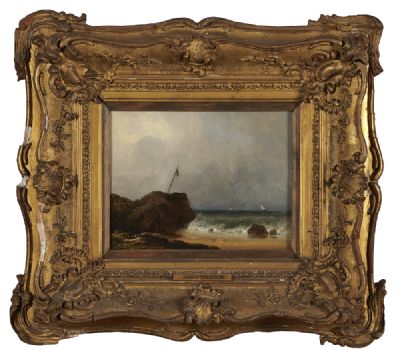
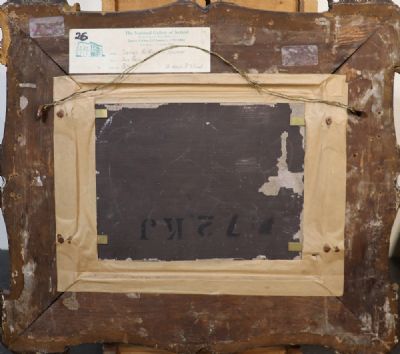
 View More Videos
View More Videos DVTV Click Here To View Video
DVTV Click Here To View Video